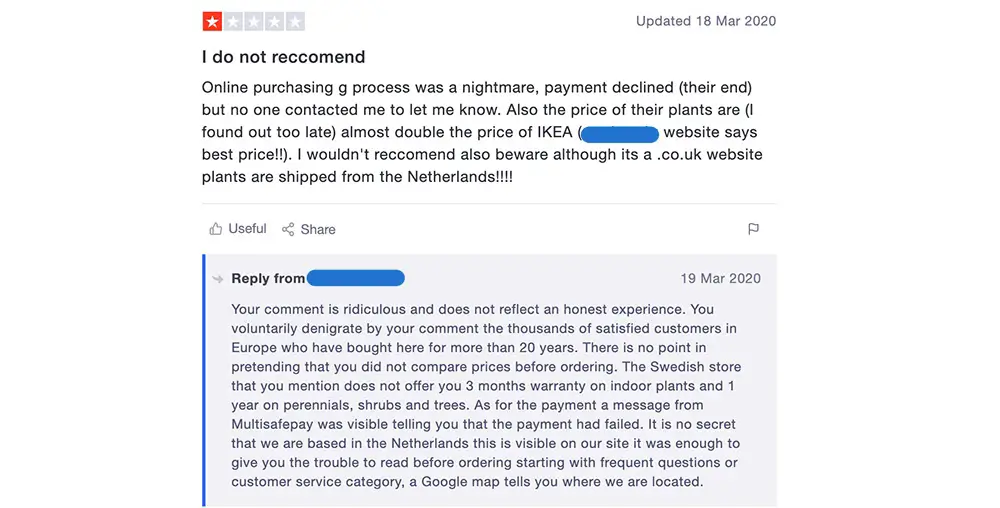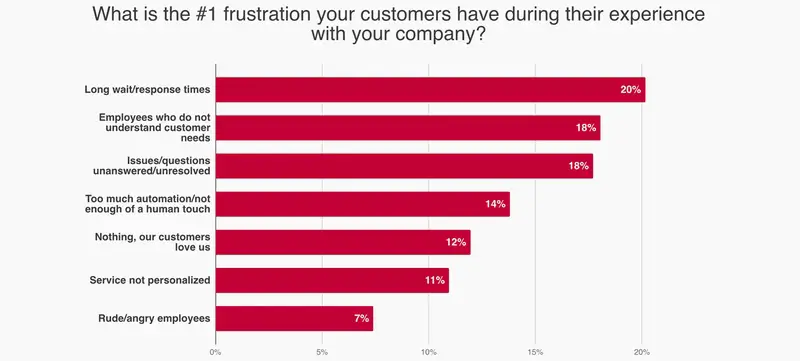BLOG
How to Respond to Negative Customer Reviews Online
Published: Apr 10, 2020
Check out our need-to-know tips on how to respond to negative customer reviews to maintain your positive reputation and provide a sparkling customer experience.
The way you handle negative customer reviews and customer complaints is becoming increasingly important for your business. In the past, dealing with negative reviews was generally a one-to-one conversation. Sure, it was still vital to respond in the best way possible to keep your customer happy – but there was also less scope for negative customer reviews to snowball and damage your brand.
In this blog we’re going to look at the following:
1. Can negative reviews be a good thing?
2. Don’t take it personally
3. Formulate a response
4. Don’t delay
5. Be humble and show empathy
6. Be personable
7. Solve their issue
8. Conclusion
With the proliferation of social media and online reviews, things have changed. According to Sprout Social, consumers tend to reach out to brands for several reasons: if they had a good experience (59%), if they have a product or service question (47%), and if they had a bad experience (40%).
Social media has empowered your customers. Now anyone with a grievance and a WiFi connection can sully your reputation by posting a negative review for the world to see. The good news is – there are tried and true methods to handle these unsatisfied queries and even use them to your own advantage!
Can negative customer reviews be a good thing?
It may seem counterintuitive, but the odd negative review can be a good thing. In fact, research shows that as many as 82% of online consumers specifically seek out negative reviews with 4.2-4.5 considered as the perfect rating, whereas “a near or perfect 5.0 rating is considered ‘too good to be true’.
Why? It’s basically down to trust. Consumers are more inclined to trust reviews when they see both good and bad scores. When no negative opinions are present, consumers suspect censorship or fake reviews.
When researching a product or service, customers also find both negative and positive reviews help to make a decision. If customers are researching a product enough that they’re delving into the negative reviews, they’re probably closer to making a purchase – so don’t rush to hide those reviews or simply delete them.
The positive side of negative customer reviews:
• Negative reviews provide transparency and build trust.
• Negative reviews make your brand look authentic and honest.
• Negative reviews empower buyers to make more informed purchase decisions.
• Negative feedback can help you improve your products and services.
• Dissatisfied customers can be converted to the brand’s biggest advocates.
• Negative reviews create buzz and can increase sales.
On that last note – wondering how can someone trashing your product or service actually help you sell more? For one, a study by Harvard Business Review looked at the sales of books by unknown authors and saw a spike in sales by an average of 45%. Meaning that negative reviews can bring awareness to your product and thus, have a positive impact on sales.
Or, if you have the guts and aren’t afraid of some good-intended humor, why not deploy something like the “Unrating Vienna” campaign that highlighted negative but funny reviews of the Austrian city.

Or the Snowbird Ski and Summer Resort “One Star” campaign that turned 1-star reviews into amazing ads?

All jokes aside, though, data shows that about 40 positive reviews are needed to undo the potential damage caused by one negative customer review. So how do you do that?
How to handle negative customer reviews
1. Don’t take it personally
Taking criticism is hard, especially when it is directed at something you and your team have poured your hearts and souls into. However, a negative review does not mean you are doing something wrong. More often than not, it just means the customer had different expectations.
Take emotions out of the equation, keep a leveled head, and follow the next steps.

2. Mull over your response
Don’t be hasty with your response. While time is a factor, take a moment to evaluate the situation, gather facts and offer the best possible solution. In some cases, you will find that the complaint is illegitimate and may not even warrant a response.
Decide whether it’s best to respond publicly or take the conversation offline. Both are OK but may be used differently depending on the situation. For example, if a customer states they simply didn’t like the product, acknowledging their feedback is oftentimes enough.
On the other hand, if you have a reviewer complaining about a defect item or unsatisfactory process, it’s worth exploring their case privately.
3. Don’t delay your response
Based on Hotjar’s State of Customer Experience research, long response times are the number one frustration customers have with brands.

Of course, this pertains mostly to cases that require further action, like a lost or defect item. Jeff Toister claims that modern businesses should aim to address customer complaints within one hour, but a 24-hour response is still acceptable. All in all, the quicker you respond, the better. No one is going to complain about your overly-prompt response.
4. Be humble and empathize
There are two extremities that you can take when responding to a negative customer review: being too apologetic or being too defensive. Find a middle ground.
Thank the customer for their feedback.
Acknowledge their complaint and apologize for any inconvenience.
If the error was fully on your end, assure the customer you are doing everything to fix it.
If, however, there was no particular error and the customer just had mismatched expectations, ask them to submit more constructive criticism on how things could be improved.
If the error was solely on the customer’s side, offer friendly advice on how to avoid such misunderstandings happening in the future. For example, if the customer is complaining about returns, gently (!) remind them to check your Return Policy or FAQ pages.
5. Be personable
This advice mainly applies to your written responses. But with email, social and messaging becoming increasingly common ways to complain, it’s all the more important to respond well in writing.
If you’re responding to negative reviews, a good rule of thumb is to judge the tone and content of your reply by how you’d speak to the reviewer in person. Obviously remain polite, but don’t forget to be human. At the end of the day you’re writing to a person, so replying like a robotic corporation with a scripted reply that lacks warmth or empathy will further frustrate your upset customer.
6. Solve the issue
It goes without saying this is the most important part. Whatever you say, however nicely you say it will not matter if the issue persists. After all, it costs 5 times more to attract a new customer than to keep an existing one, and your existing customers are also more likely to try new products and spend more.
By making a real effort to fix their issue, you can actually turn a negative reviewer into a brand advocate. So, replace their product, refund or compensate accordingly where necessary. Yes, it’s going to take a bit of time and effort, but realistically the return on garnering a great reputation could make it one of the smarter investments you make.
After all, you not only gain a satisfied customer who is likely to change their review but you also show potential customers reading the reviews you’re a brand that looks after your customers and really cares.
Conclusion
For the most part, you can fix the majority of negative reviews and complaints by simply being proactive, genuine and helpful. With customer lifetime value probably the most important metric in your business right now, it definitely pays to invest in keeping your customers happy.
Responding to negative reviews appropriately ensures both your customer experience and your reputation will remain untarnished. Follow the simple guidelines we’ve outlined (along with your common sense) and you can turn negative customer reviews into positive customer experiences.
The best way to answer a negative review is to firstly, address the reviewer, and apologize and sympathize with their situation. If the fault is on your part take responsiblity and do everything you can to make things right. Try to take the issue offline if you can.
Yes. You must respond to all negative reviews. If you don’t it could be seen that you don’t care about your customers’ feedback or experiences. However, if you respond it shows you take customer care seriously and can increase customer advocacy.